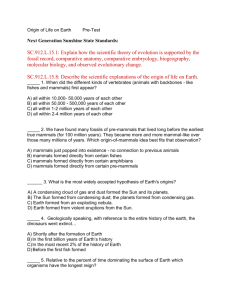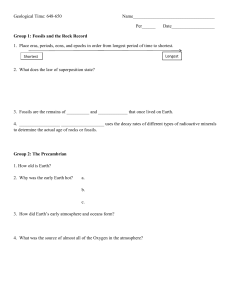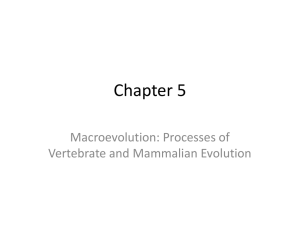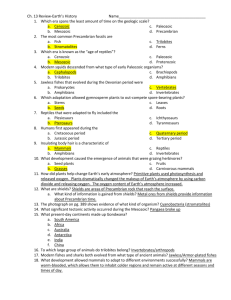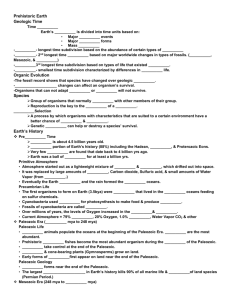Vertebrates
advertisement
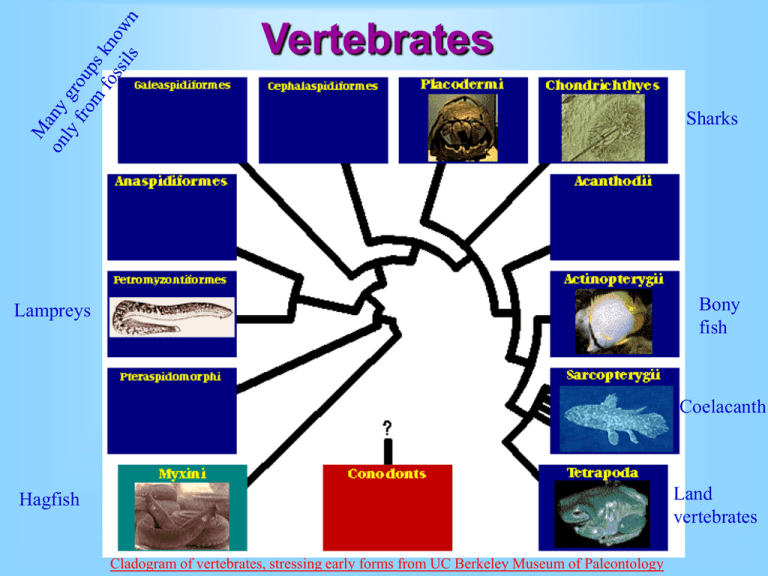
Vertebrates Sharks Bony fish Lampreys Coelacanth Land vertebrates Hagfish Cladogram of vertebrates, stressing early forms from UC Berkeley Museum of Paleontology Vertebrate characters • • • • Cranium – brain case Vertebrae (spinal protection of cartilage or bone) – almost all * agility * speed No larval stages Evolved during Cambrian (early Paleozoic) Myllokunmingia fossil from SE China, -530 my Trends in vertebrate evolution • • • • • • • improvements in vertebral column – cartilage, bone gill slit supports – jaws, other head bones appendages – fins, legs, wings respiration – gills & lungs circulation – heart reproduction – eggs, shells, “live” young existing (& some extinct) classes trace some of the most important advances along the vertebrate evolutionary path – next slides follow these No Jaws • • Hagfish * cartilage * partial cranium * slime a defense mechanism Lampreys * cartilage * full cranium * fish parasites & free living hagfish tie themselves into knots to clean themselves Jaws • evolved from gill arches • later bore teeth • mid Paleozoic (Silurian) origin recent Swedish shark Dunkleosteus Devonian (mid Paleozoic) Placoderm Carcharodon megalodon Miocene (Cenozoic) shark Jaws II 1m Jaws III • also: * articulated cranium & spine * appendages (fins) some paired • modern day Cartilaginous Fish * sharks, rays, etc. * no swim bladder – must swim to “levitate” Manta Ray Bone • Bony fish = ray-finned fish * also bony scales * most numerous & diverse vertebrate * lungfish have “lungs” • gut pockets • modified circulation Legs • Amphibians * the mosses of the animal world * limbs supported by bones • support • movement * articulated to “girdles” • connections to spines • hips and shoulder * but amphibians tied to water: • at least eggs (shell-less) • & larval stages young Rough-skinned Newt Legs II • more on Amphibians * land life advantages • more oxygen • prey – arthropods & plants • fewer (no?) predators Northwest Tailed Frog * sound / sight / balance improvements (terrestrial sensors) • ears and eyes * first amphibians: Devonian (mid Paleozoic) Shelled eggs • Reptiles * amniote eggs with: • extra-embryonic membranes • shells for protection * * * * dry scaly skin internal fertilization adult care for young kidneys conserve water Reptiles II • Evolved in late Paleozoic (Carboniferous) • Huge diversity – polyphyletic with many • long-lived lines from the end of the Paleozoic Two early lines * Sauropsids – most of the diverse lines * Synapsids – ultimately gave rise to mammals • • • • • • • Birds Just another reptilian group? Feathers – insulating, flight (modified scales) Bones hollow Beaks Thermoregulation – high metabolism rates All adaptations for flight Patterns of behavior * Elaborate mating behavior * Maternal/paternal care * Migration Birds II • Evolved from theropod dinosaurs, mid Mesozoic Archaeopteryx lithographica 150 my Birds III Sinosauropteryx prima 125 my Caudipteryx zoui 125 my Mammals I • • • • • Hair (modified scales) Milk fed to young Live young (except for 3 that lay eggs) Precise teeth that fit together 3 middle ear bones (derived from jaw bones) Mammals II • Three major lines * monotremes – egg layers * marsupials – pouched * eutherian – placental Spiny echidna, egg-layer Marsupial “mouse” Blue whale, largest mammal Mammals IIIA • Evolved in early Paleozoic 200 mya • Adaptive radiation during mesozoic & cenozoic tied to continental drift – see ST Fig 26.2 * End of mesozoic opened habitats * Mammals much more efficient terrestrial forms • Drifting continents isolated mammalian groups on “rafts” Mammals IIIB Early Triassic Late Triassic * Early Cretaceous Late Cretaceous • Compare with ST Fig 26.2 Mammals IIIC Modern day mammalian distribution Mammals IV - Primates • • • 3 present groups Galago * prosimians – lemurs, galagos * tarsiers * monkeys, apes, humans Early primates evolved in early Cenozoic from rodent ancestors 5 features preadapted early primates to modify later in the line toward humans * enhanced vision * upright walking * modifications in hand bones & muscles * generalized teeth * social behavior (& increases in brain capacity and complexity) Barbary Macaque Tarsier Human evolution • Humans evolved in Africa • Earliest huminoids – mid Cenozoic (25 mya) • • • • • * cooler climate led to challenges * later radiation of “southern apes” (Australopithecus) 4-3 mya * first appearance of Homo ~ 2.5 mya Homo erectus leaves Africa ~2 mya Homo sapiens evolved 150,000 ya Homo neanderthalensis evolved 250,000 ya; extinct 35,000 Recent studies show no DNA mixing or carryover of H. n. DNA in modern human lines Most evidence supports Out of Africa theory rather than multiregionalism • Best site for current status of human evolution facts: http://www.talkorigins.org/faqs/homs/ Human evolution timeline Chart from: http://www.talkorigins.org/faqs/homs/species.html Interactive Human Evolution
